Frédéric Chopin
![]()
Chopin is a redirect to this article. For other meanings, see Chopin (disambiguation).
Fryderyk Franciszek Chopin (French Frédéric François Chopin, Polish Fryderyk Chopin, less commonly Szopen; * 22 February or 1 March 1810 in Żelazowa Wola, in what was then the Polish Duchy of Warsaw; † 17 October 1849 in Paris) was a Polish composer, pianist and piano teacher. He held French citizenship from 1835.
Chopin's father was French, his mother Polish. He grew up in a loving, stimulating domestic atmosphere. His lifelong close ties to his family and homeland were decisive for his personality. Considered a child prodigy, Chopin received his musical education in Warsaw, where he also composed his first pieces. He spent the first 20 years of his life in Poland, which he left on November 2, 1830 for professional and political reasons. From October 1831 until his death (1849) Chopin lived mainly in France. His life was marked by illness. At last he was penniless and dependent on the help of friends. He died at the age of 39, most likely from pericarditis (inflammation of the heart sac) as a result of tuberculosis.
Like Robert Schumann, Franz Liszt, Felix Mendelssohn Bartholdy and others, Chopin is a representative of Romanticism, which had its heyday in Chopin's adopted country of France between 1815 and 1848. As a composer, he wrote almost exclusively works for piano. Chopin's compositional style was influenced by Polish folk music, the classical tradition of Bach, Mozart, Weber, Hummel and Schubert, but especially by the bel canto style of contemporary Italian opera and its representative Vincenzo Bellini. The atmosphere of the Parisian salons, in which Chopin frequently frequented, was a formative influence. Here he developed his skills in free improvisations on the piano, which often became the basis of his compositions. His innovations in all elements of composition (melody, rhythm, harmony and forms) and his incorporation of the Polish musical tradition with its emphasis on national character were important for the development of European music.
Even during his lifetime, Chopin was considered one of the leading musicians of his time. His piano playing and his work as a teacher were considered exceptional because of the expansion and exploitation of the technical and tonal possibilities of the instrument, the sensitivity of touch, the innovations in the use of pedals and fingering. His ideas about piano playing (facilité "lightness", rejection of the percussive "knocking" attack, model of singing, of the so-called bel canto in agogic and articulation, rejection of mechanical practice without musical commitment, use and training of the fingers according to their natural physiological conditions instead of egalitarian finger drill) are still considered fundamental in piano pedagogy, or their importance is only now being properly recognized (e.g. in the prevention of playing damage).
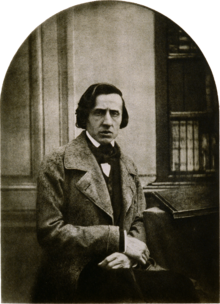
Frédéric Chopin, photo portrait by Louis-Auguste Bisson around 1849
Chopin's work in arrangements and adaptations
Godowsky Studies on the Etudes of F. Chopin
→ Main article: Studies on the Etudes of F. Chopin (Godowsky)
Chopiniana
→ Main article: Les Sylphides
Digressions on individual topics
Family tree of the Chopin family
The family tree of the Chopin family can be traced on the paternal side to the great-great-grandparents.
| Family tree of the Chopin family | ||||||||
| Great-great-grandparents | François Chapin | Estienne Bastien | Jean Deflin | Claude Renard | ? | ? | ? | ? |
| Great-grandparents | Nicolas Chopin | Jean Charles Deflin | Mikołaj KrzyżanowskiBarbara | ? | ||||
| Grandparents | Fryderyk Choppen | Jakub Krzyżanowski | ||||||
| Parents | Nicolas Chopin | |||||||
| Children | Ludwika Marianna Chopinówna | Fryderyk Franciszek Chopin | Izabella Chopinówna | Emilia Chopinówna | ||||
Chopin Family
(All oil paintings by Ambroży Mieroszewski)
· 
Nicolas Chopin
· 
Tekla Justyna Chopin,
née Krzyżanowska.
· 
Ludwika Marianna Chopin
· 
Fryderyk Chopin
· 
Izabela Chopin
· 
Emilia Chopin
French citizenship of Chopin
Chopin was entitled to French citizenship through his French-born father, which he received in addition four years after his arrival in France. The entitlement derived from the Code Napoléon of 1804, Article 10 of which stated: "Every child born abroad of a Frenchman is a Frenchman." (French Tout enfant né d'un Français a l'étranger est Français. ). Article 12 further stated that "the status of a foreigner who marries a Frenchman follows the status of her husband" (French L'étrangère qui a épousé un Français suivra la condition de son mari. ). This circumstance enabled Chopin to avoid acquiring the status of political refugee with a Russian passport, for he was, according to the principle of territoriality in force in Poland, a Pole with a passport issued by the Russian Tsar. This would also have presented major administrative problems in obtaining foreign visas from the Russian embassy. His first French passport was issued on 1 August 1835.
Legally speaking, the composer had two citizenships. According to the Code civil, he was automatically French through his father, and at the same time Polish as a citizen of the Duchy of Warsaw. Through the accumulation of both legal titles, the status of dual citizenship remained effective throughout his life. In this respect, Chopin was not an emigrant in France like many of his friends - even if he always identified himself with emigration, for his personal preference was unequivocal. As a citizen and patriot, he was and remained a Pole who took a passionate interest in the tragic fate of his people.
On the occasion of Chopin's trip to London, he received a passport issued by the French authorities on 7 July 1837. It is noted there both that he has "grey-blue eyes" (which does not correspond to Delacroix's portrait of the composer) and that Chopin is descended "from French parents".
Chopin's Heart
At his express wish, Chopin's heart was secretly brought to his Polish homeland by his sister Ludwika, where she kept it in her apartment on Ul. Podwale in Warsaw's Old Town. After a few weeks, the heart was entrusted to the priests of the Church of the Holy Cross in Ulica Krakowskie Przedmieście, where it was laid out first in the sacristy and then in the crypt of the lower church. During the Warsaw Uprising, heavy fighting was fought near the church. The chaplain of the German troops, Father Schulz, persuaded Priest Niedziela to hand over the urn to the Germans to save it from destruction. On September 4, the Germans handed over the relic to Archbishop Antoni Władysław Szlagowski and filmed this event for propaganda purposes. The urn containing Chopin's heart was kept in Milanówek, where the Warsaw bishops were interned. It stood on the piano in the salon chapel on the first floor of the presbytery of the Holy Jadwiga Church until October 17, 1945. After the end of the war, on the anniversary of Chopin's death, the pastor of the Holy Cross Church, priest Leopold Petrzyk (1890-1960), composer Bolesław Woytowicz (1899-1980) and musicologist Bronisław Sydow (1886-1951) brought the urn to Żelazowa Wola. From there there was a ceremonial return of the urn, accompanied by Polish President Bolesław Bierut (1892-1956), from Chopin's birthplace back to the Church of the Holy Cross in Warsaw. There the column with Chopin's heart contains the inscription: in Polish Gdzie skarb twój, tam i serce twoje '"Where your treasure is, there is your heart"' (Matthew 6/21). The indication of the date of birth (22 February instead of 1 March) does not correspond to today's knowledge.
In 1926/1928 and again in 1929, Marshal Józef Piłsudski attempted to transfer Chopin's bones from France to Poland and to bury them in the Wawel Cathedral in Krakow at the place where Poland's kings and freedom fighters rest. However, the political circumstances at that time - and also later - did not allow this.
Chopin and religion
Chopin felt deeply connected to Christianity. In many letters to his family who remained in Poland, he expressed his longing for the festivals celebrated in the Polish Catholic tradition, for example at Christmas or Easter - with customs that were completely foreign to the French, such as Pasterka on Christmas Eve and the Christmas dinner (Polish: Wigilia) with Polish Christmas wafers and Polish Christmas carols (Polish: Bożonarodzeniowe opłatki i kolędy). This involves breaking each other's wafers in a family circle, wishing each other luck and blessings for the coming year. Or the blessing of Easter food (Polish: Wielkanocne święcone) on Holy Saturday, when the Święconki are taken to the Catholic parish church and blessed and sprinkled with holy water before traditionally being eaten at Easter breakfast on Easter Sunday with the family.
List of Chopin interpreters
→ Main article: List of Chopin performers
The list of Chopin interpreters contains well-known pianists who have mainly worked with Chopin works or who have distinguished themselves through special interpretations.
List of important Chopin pupils
This list contains names of Chopin's pupils and grand-pupils who were important for the spread of Chopin's teachings.
- Karol Mikuli (1819-1897)
- Raoul von Koczalski (1885-1948)
- Jane Stirling (1804-1859)
- Marcelina Czartoryska (1817-1894)
- Thomas Dyke Acland Tellefsen (1823-1874)
- Friederike Streicher (1816-1895)
- Vera Rubio (1816-1880)
- Elizavieta Tchernischeff (Czernicheff) (1818-1890)
- Georges-Amédée-Saint-Clair Mathias (1826-1910)
- Adolf Gutmann (1819-1882)
- Emilie von Gretsch (1821-1877)
- Camille Dubois née O'Meara (1828-1907)
- Wilhelm von Lenz (1808-1883)
- Maria Alexandrova Harder (1833 - after 1880)
- Pauline Viardot née García (1821-1910)
- Marie Roubaud née de Cournand (1822-1916)
- Eliza Peruzzi née Eustafiew
- Joseph Schiffmacher (1827-1888)
- Carl Filtsch (1830-1845)
- Zofia Zaleska née Rosengardt (1824-1868)
International Chopin Competition
→ Main article: International Chopin Competition
The Reception of Chopin in the Time of National Socialism
From 1934 onwards, Adolf Hitler wanted a reconciliation with Poland with the aim of strengthening its foreign policy. Propaganda Minister Joseph Goebbels signed a German-Polish media agreement. According to this, "a friendly atmosphere was to be created and reconciliation advanced". Musically, Fryderyk Chopin had to be used for this purpose: His works were played on German radio stations. German opera houses danced ballets to Chopin's music, and Germany supported Poland financially in the acquisition of valuable Chopin manuscripts.
With the British-French guarantee declaration of 31 March 1939 to Poland, which had Poland's independence as its object, the mood tilted. The National Socialists imputed revolutionary thoughts to Chopin's music. Since then, it was forbidden to perform musical works that were connected with the Polish national tradition. This also applied in the Warsaw ghetto, where the critic Marcel Reich-Ranicki (1920-2013) reports in his autobiography that occasionally a pianist would play a lesser-known work by Chopin as an encore and, when asked by a supervisor whose piece he was playing, would cynically refer to Schumann.
Hans Frank (1900-1946), Nazi governor-general of Poland, called by contemporaries the "Butcher of Poland" or the "Jew Butcher of Krakow," attempted to Germanize Chopin during the opening of a Chopin exhibition in Krakow on October 27, 1943: "Frederick Schopping was a genius, so he could not be Polish. This is the greatest composer the German soil has produced." It is said that while Frank wanted to bring culture to the "Slavic barbarians," he himself also had a strange affinity for the culture of Poland.
On 25 September 1939, at 8 o'clock, there was a live broadcast of a piano concerto on Polish Radio. Władysław Szpilman (1911-2000) was playing Chopin's Nocturne in C-sharp minor (B. 49, KK IVa/16 Cho 127:Con gran espressione, also called "Nocturne") when the first German bombs fell on Warsaw and Polish Radio interrupted its broadcast because of the attack of German troops on Warsaw. With exactly the same piece, Polish Radio resumed its broadcasts after the Second World War.
The Chopin Monument in Warsaw was designed by Wacław Szymanowski (1859-1930) in 1907 and was originally intended to be inaugurated on the occasion of Chopin's 100th birthday in 1910. Due to controversy over its design and the First World War, it was not erected until 1926 in Łazienki Park. It depicts Chopin seated under a stylized pianist's hand, which merges into the eagle's head of the coat of arms of Poland. After the invasion of Poland, the German Wehrmacht blew up this monument on 31 May 1940. After the casting mould survived the Second World War, it was possible to make a replica of the monument after the war, which was reinstalled in its original place in 1958.
· 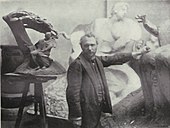
Wacław Szymanowski in his studio in Kraków while working on the monument to Chopin (1911)
· 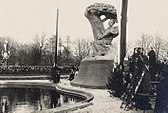
Unveiling of the Warsaw Chopin Monument 1926
· 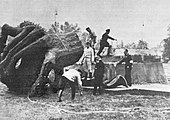
Destruction of the Chopin Monument by German troops on 31 May 1940
· .jpg)
1958 rebuilt monument to Chopin in Warsaw
Pianos and grand pianos from the time of Chopin
There are several original, still playable uprights and grand pianos by Pleyel, Érard and Broadwood that are associated with Chopin or on which Chopin can be shown to have played. Chopin had a good relationship with the three important piano makers mentioned above. Camille Pleyel was also friends with Broadwood and even recommended that Chopin make use of Broadwood's instruments on his trip to England in 1848. Chopin had a close, friendly relationship with Camille Pleyel, which was characterized by mutual esteem and trust. Pleyel provided Chopin with his best instruments free of charge, which were then sold after a while, sometimes by Chopin himself (for example the "pianino", Pleyel No. 6668 from Valldemossa after the stay in Mallorca or the Pleyel grand piano No. 13819 brought to London for the trip to England). The following instruments by Pleyel could be proven on which Chopin certainly played:
- Piano ("pianino") No. 6668 / Valldemossa Charterhouse.
- Grand piano ("piano à queue") No. 7267 / Musée de la musique, Paris.
- Grand piano ("piano à queue") No. 12480 / Stiftelsen Musikkulturens Främjande, Stockholm.
- Grand piano ("piano à queue") No. 13189 / Cobbe Collection, Hatchlands Park, Surrey UK.
- Piano ("pianino") No. 13555 / Narodowy Instytut Fryderyka Chopina, Warsaw.
- Grand piano ("piano à queue") no. 13716 / Museum of the Jagiellonian University, Cracow.
- Grand piano ("piano à queue") No. 13823 / Museum of the Jagiellonian University, Cracow.
- Grand piano ("piano à queue") No. 14810 / Frédéric Chopin Museum Warsaw.
- Grand piano ("piano à queue") No. 11265 / Private property of a German collector.
Specifically:
- Pleyel piano no. 6668. Completed: 1838.
The instrument was sent by Pleyel to Mallorca in January 1839. Before returning home in February 1839, Chopin sold the piano for Pleyel to the banker Canut.
Current location: Valldemossa Charterhouse, cell 4, Chopin Museum.
- Pleyel grand piano no. 7267. Completed: 1839.
The instrument was made available to Chopin by Pleyel from October 1839, when he moved to 5 rue Tronchet. It was sold to Natalia Obreskoff, an admirer of Chopin, in May 1841.
Current location: Musée de la musique, Paris.
- Pleyel grand no. 12480. Completed: 1845.
It was made available to Chopin from December 1846 and sold in 1847.
Current location: The Nydahl Collection, Stiftelsen Musikkulturens Främjamde, Stockholm.
- Erard grand no.713. Completion: 1843.
Jane Stirling, who also owned a Pleyel grand (no. 13823), bought the instrument in 1843, the year she became a pupil of Chopin. The grand piano had been back in England since 1847 and was moved to Keir House, the Stirling family home in Scotland, in October 1848. It was here that Chopin stayed during his trip to Scotland.
Today's location: The Cobbe Collection in Hatchlands Park, East Clandon, Surrey, UK.
- Pleyel grand piano no. 11265. Completed in 1844.
It was purchased by Chopin and stood in his apartment in Paris, Square d'Orléans 9, from 29 November 1844 to 12 June 1845. A restoration was carried out in 2009 by the firm of Edwin Beunk & Johan Wennink, Enschede, The Netherlands.
Current location: private property of a German collector.
- Pleyel grand no. 12342. Completed: 1845.The
grand piano was donated to the Polish Library in Paris (Bibliothèque Polonaise de Paris, Biblioteca Polska w Paryżu) by Madame Migaux in 2006.
An accompanying letter states that Chopin is said to have played on this instrument at "réunions musicales" hosted by Monsieur de Bantel in Evreux.
Present location: Bibliothèque Polonaise de Paris, Salon Chopin.
- Pleyel piano no. 13555, completion: 1846 or 1847.
Chopin chose the instrument in 1848 for his pupil Madame Raymond. There is Chopin's signature written in pencil on the action of the piano.
Present location: Narodowy Instytut Fryderyka Chopina, Warsaw.
- Pleyel grand no. 13716. Completion: 1847.
Chopin chose the instrument for the countess Katarzyna Potocka. It was sold to Poland on 7 February 1848.
Current location: Museum of the Jagiellonian University (Polish: Universytet Jagielloński), Krakow.
- Pleyel grand no.13819. Completion: January 1848.
Chopin called this grand "his own", but it had only been made available to him by Pleyel. The instrument was most likely used in
Chopin's last concert in Paris on 16 February 1848. He took it to London in April 1848 and gave his first concert on it at Gore House, the residence of Lady Blessington and Count d'Orsay. When he left London he sold it for Pleyel to Lady Trotter, widow of Sir Coutts Trotter, London, at the end of July 1848.
Present location: The Cobbe Collection, Hatchlands Park, East Clandon, Surrey, UK.
- Pleyel grand piano no. 13823. Completion: 1847.
The grand piano was bought on 15 November 1847 for 2500 francs by Jane Stirling in Paris. It stood in Chopin's salon according to a letter communication from Chopin to Franchomme dated 11 August 1848. Inside the instrument is a signature written in ink: "Frédéric Chopin 15 novembre 1848". Édouard Ganche received the piano on 30 July 1927 from Anne D. Houston, a great-niece of Jane Stirling.
Current location: Museum of the Jagiellonian University, Green Hall (Polish: Muzeum Universytetu Jagiellońskiego, Zielona Sala), Krakow.
- Broadwood grand piano no. 17047. Completed: 1847.
The instrument was made available to Chopin for his concerts in London in May, June, July and November 1848, as well as the concert in Manchester in August 1848. Chopin gave the last public concert of his career on this instrument at the Guildhall in London on 16 November 1848. The piano is the property of the Royal Academy of Music and was placed on permanent loan to the Cobbe Collection in 1991. It has been restored by David Hunt.
Current location: The Cobbe Collection in Hatchlands Park, East Clandon, Surrey, UK.
- Pleyel grand piano no. 14810. Completed: November 1848.
Pleyel placed it at Chopin's disposal from the end of November 1848 until his death on 17 October 1849. It was bought by
Jane Stirling after Chopin's death on 11 December 1849 and brought to Warsaw as a gift for Chopin's elder sister Ludwika Jędrzejewicz in June 1850 by sea Le Havre - Gdansk in a tinplate ("en fer blanc") box protecting against dampness, and remained in family ownership. On April 3, 1924, Maria Ciechomska, a granddaughter of Ludwika, sold the piano to the National Museum in Warsaw (Muzeum narodowe w Warszawie). During the Second World War the instrument was evacuated to Salzburg. In February 1968 it was given on permanent loan to the Chopin Society (Towarzystwo im.[=imienia] Fryderyka Chopina). Around 1960 the piano was restored according to the ideas and technical possibilities of the time. From today's point of view the restoration has ruined the instrument. It was robbed of its historic sound and is now considered unplayable. A rough idea of the sound of this instrument is given by a recording with Zbigniew Drzewiecki (Polskie Nagrania, Muza X 0117)
Today's location: Frédéric Chopin Museum Warsaw (Muzeum Fryderyka Chopina w Warszawie).
- Pleyel piano no. 15025.
Chopin never played on this instrument, which is now in the salon of the Maison de George Sand in Nohant. It was only purchased by George Sand on 25 May 1849, i.e. after his separation from Chopin.
Protection of Chopin's heritage
In Poland, according to Article 1(1) of the Act of 3 February 2001 on the Protection of the Heritage of Fryderyk Chopin, his works and related objects constitute a national good subject to special protection. The law concerns the use of Chopin's image and surname in trademarks, while it does not apply to his works which are in the public domain. The National Fryderyk Chopin Institute (NIFC=Narodowy Institut Fryderyka Chopina) deals with the protection of the composer's heritage, supported by the Patent Office of the Republic of Poland. Companies wishing to register a trademark including the name or image of Fryderyk Chopin must first obtain permission from the NIFC. The Institute requires that products bearing the image or name of a composer be of high quality and associated with Poland. In order to accept the use of such a trademark for commercial purposes, the Institute charges an annual fee and a percentage of the profit made.

Column with Chopin's heart in the Church of the Holy Cross in Warsaw. Carrara marble epitaph (1880) by Leonard Marconi (1835-1899).
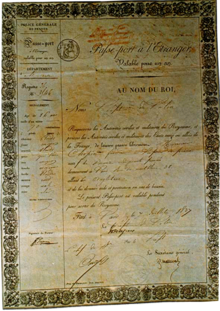
French passport of Chopin, which allowed him to leave France, 7 July 1837. Valid for one year.
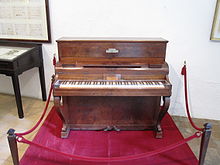
Pleyel piano no. 6668, now in the Valldemossa Charterhouse, cell 4.
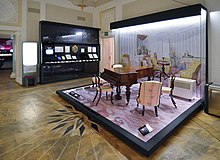
The last Pleyel grand piano (no. 14810) on which Chopin played and composed from November 1848 until his death (Frédéric Chopin Museum Warsaw).
Questions and Answers
Q: Who was Fryderyk Franciszek Chopin?
A: Fryderyk Franciszek Chopin was a Polish composer and virtuoso pianist. He is considered one of the greatest Romantic piano composers.
Q: Where was he born?
A: He was born in Żelazowa Wola, a village in the Duchy of Warsaw.
Q: Was he a child prodigy?
A: Yes, he was a famous child prodigy.
Q: Where did he complete his music education?
A: He completed his music education in Warsaw.
Q: How old was he when he left Poland?
A: He left Poland at age 20, shortly before the November 1830 Uprising.
Q: What year did Chopin leave Poland?
A: Chopin left Poland in 1830.
Search within the encyclopedia